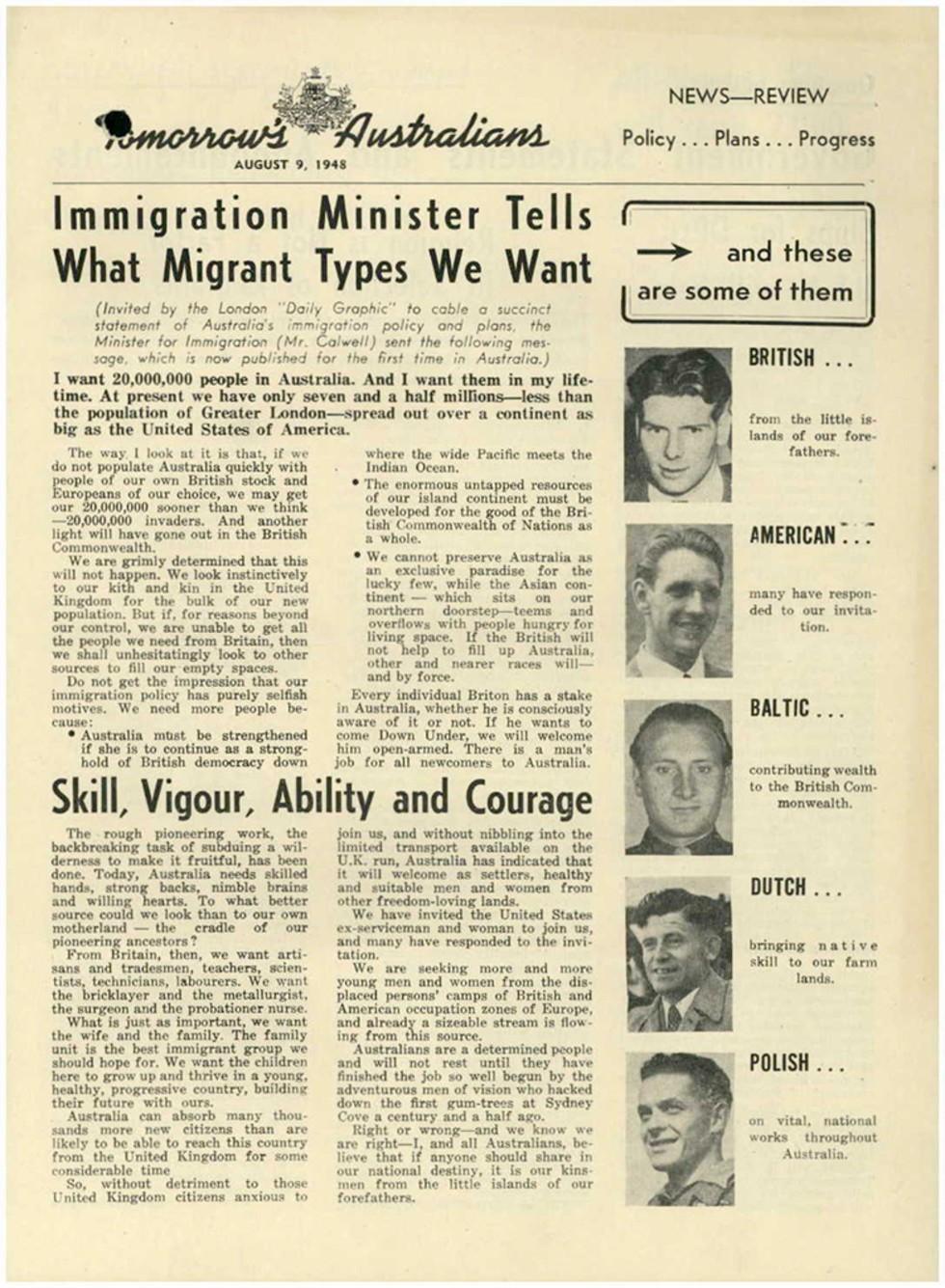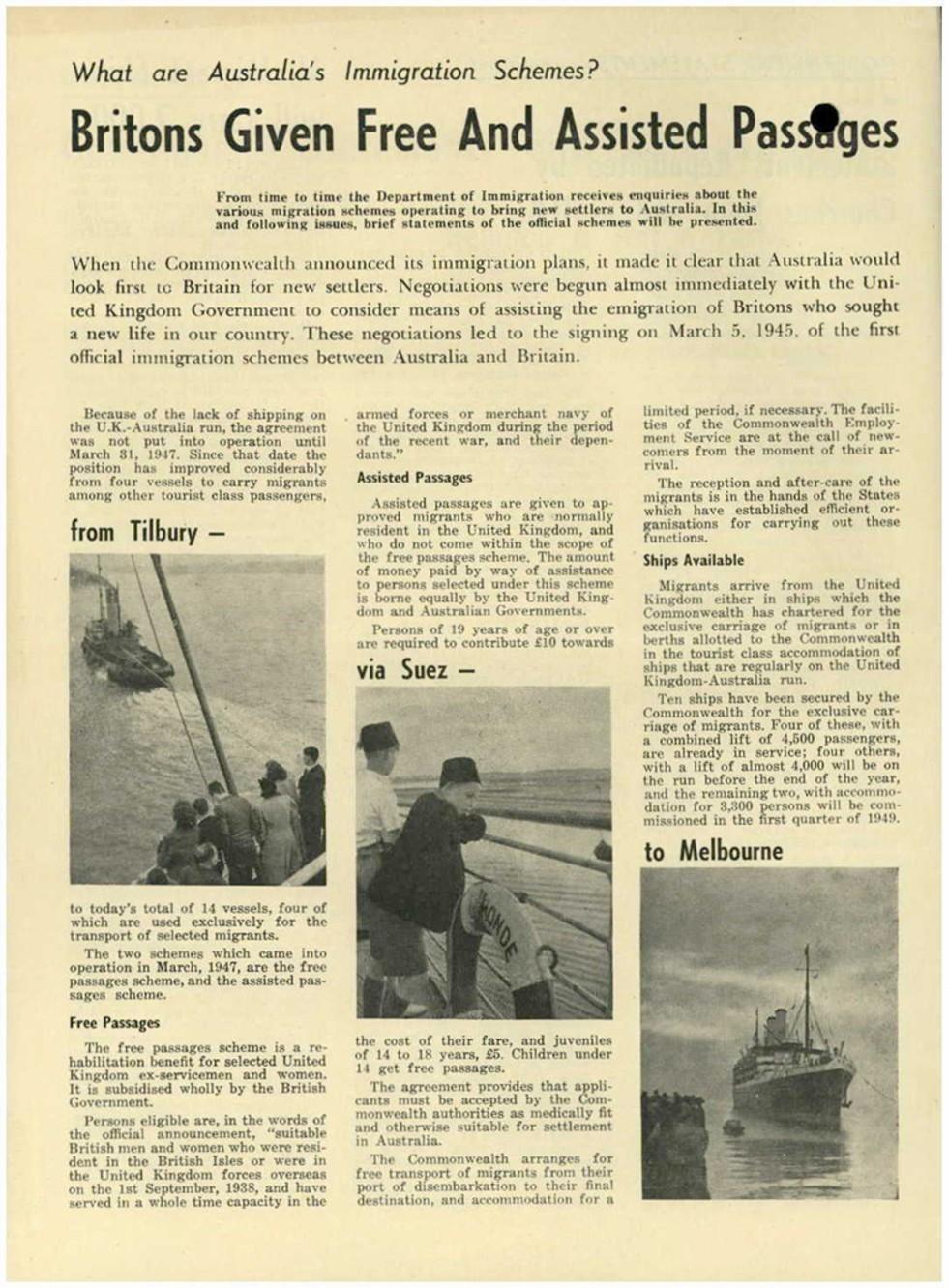


Aboriginal and Torres Strait Islander people should be aware that the National Archives' website and collection contain the names, images and voices of people who have died.
Some records include terms and views that are not appropriate today. They reflect the period in which they were created and are not the views of the National Archives.




[Page 1. Excerpt from a newspaper or booklet.]
[Header in large italicised text:] Tomorrow's Australians
AUGUST 9, 1948
NEWS—REVIEW
Policy…Plans…Progress…
[Headline:] Immigration Minister Tells What Migrant Types We Want
[Section in italics:] (Invited by the London "Daily Graphic" to cable a succinct statement of Australia's immigration policy and plans, the Minister for Immigration (Mr. Calwell) sent the following message, which is now published for the first time in Australia.) [end italics.]
[Section in bold text:] I want 20,000,000 people in Australia. And I want them in my life-time. At present we have only seven and a half million - less than the population of Greater London - spread out over a continent as big as the United States of America. [end bold text.]
The way, I look at it is that, if we do not populate Australia quickly with the people of our own British stock and Europeans of our choice, we may get our 20,000,000 sooner than we think - 20,00,000 invaders. And another light will have gone out in the British Commonwealth.
We are grimly determined that this will not happen. We look instinctively to our kith and kin in the United Kingdom for the bulk of our new population. But if, for reasons beyond our control, we are unable to get all the people we need from Britain, then we shall unhesitatingly look to other source to fill our empty spaces.
Do not get the impression that our immigration policy has purely selfish motives. We need more people because:
[Dot point:] Australian must be strengthened if she is to continue as a stronghold of British democracy down where the wide Pacific meets the Indian Ocean.
[Dot point:] The enormous untapped resources of our island continent must be developed for the good of the British Commonwealth of Nations as a whole.
[Dot point:] We cannot preserve Australia as the exclusive paradise for the lucky few, while the Asian continent - which sits on our northern doorstep - teems and overflows with people hungry for living space. If the British will not help to fill up Australia, other and nearer races will - and by force.
[End dot points.]
Every individual Briton has a stake in Australia, whether he is consciously aware of it or not. If he wants to come Down Under, we will welcome him open-armed. There is a man's job for all newcomers to Australia.
[Subheading in large text:] Skill, Vigour, Ability and Courage
The rough pioneering work, the backbreaking task of subduing a wilderness to make it fruitful, has been done. Today, Australia needs skilled hands, strong backs, nimble brains and willing hearts. To what better source could we look than to our own motherland - the cradle of our pioneering ancestors?
From Britain, then, we want artisans and tradesmen, teachers, scientists, technicians, labourers. We want the bricklayer and the metallurgist, the surgeon and the probationer nurse.
What is just as important, we want the wife and the family. The family unit is the best immigrant group we should hope for. We want the children here to grow up and thrive in a young, healthy, progressive country, building their future with ours.
Australia can absorb many thousands more new citizens than are likely to be able to reach this country from the United Kingdom for some considerable time.
So, without detriment to those United Kingdom citizens anxious to join us, and without nibbling into the limited transport available on the U.K. run, Australia has indicated that it will welcome as settlers, healthy and suitable young men and women from other freedom-loving lands.
We have invited the United States ex-serviceman and woman to join us, and many have responded to the invitation.
We are seeking more and more young men and women from the displaced persons' camps of British and American occupation zones of Europe, and already a sizeable stream is flowing from this source.
Australians are a determined people and will not rest until they have finished the job so well begun by the adventurous men of vision who hacked down the first gum-trees at Sydney Cove a century and a half ago.
Right or wrong - and we know we are right - I, and all Australians, believe that if anyone could share in our national destiny, it is our kinsmen from the little islands of our forefathers.
[To the right of the article above, there is a column of captioned photos illustrating some of 'Tomorrow's Australians'. At the top of the column, an arrow connects the page's primary headline 'Immigration Minister Tells What Migrant Types We Want' to a subheading: 'and these are some of them'.]
[Five black and white photos of different men, showing only their faces. The captions read:]
BRITISH… from the little islands of our forefathers.
AMERICAN… many have responded to our invitation.
BALTIC… contributing wealth to the British Commonwealth.
DUTCH… bringing native skill to our farmlands.
POLISH… on vital, national works throughout Australia.
[Page 2. Excerpt from a newspaper or booklet.]
[Heading in italics:] What are Australia's Immigration Schemes?
[Heading in larger, bold letters:] Britons Given Free and Assisted Passages
[Small text:] From time to time the Department of immigration receives enquiries about the various migration schemes operating to bring new settlers to Australia. In this and following issues, brief statements of the official schemes will be presented.
[Large text:] When the Commonwealth announced its immigration plans, it made it clear that Australia would look first to Britain for new settlers. Negotiations were begun almost immediately with the United Kingdom Government to consider means of assisting the emigration of Britons who sought a new life in our country. These negotiations led to the signing on March 5,1945, of the first official immigration schemes between Australia and Britain.
[The article below is illustrated with three black and white photos underneath captions in large, bold text. The first photo, labelled 'from Tilbury – ', shows a group of people watching a ship arrive. The second photo, labelled 'via Suez – ', shows two boys wearing fez hats, leaning on the railing of a boat as it passes some land. The third photo, labelled 'to Melbourne', shows a crowd on a pier watching a ship arrive.]
[Article begins:]
Because of the lack of shipping on the U.K.-Australia run, the agreement was not put into operation until March 31, 1947. Since that date the position has improved considerably from four vessels to carry migrants among other tourist class passengers, to today's total of 14 vessels, four of which are used exclusively for the transport of selected migrants.
The two schemes which came into operation in March, 1947, are the free passages scheme, and the assisted passages scheme.
[Subheading in bold:] Free Passages
The free passages scheme is a rehabilitation benefit for selected United Kingdom ex-servicemen and women. It is subsidised wholly by the British Government.
Persons eligible are, in the words of the official announcement, "suitable British men and women who were resident in the British Isles or were in the United Kingdom forces overseas on the 1st September, 1938, and have served in a whole time capacity in the armed forces or merchant navy of the recent war, and their dependants."
[Subheading in bold:] Assisted Passages
Assisted passages are given to approved migrants who are normally resident in the United Kingdom, and who do not come within the scope of the free passages scheme. The amount of money paid by way of assistance to persons selected under this scheme is borne equally by the United Kingdom and Australian Governments.
Persons of 19 years of age or over are required to contribute £10 towards the cost of their fare, and juveniles of 14 to 18 years, £5. Children under 14 get free passages.
The agreement provides that applicants must be accepted by the Commonwealth authorities as medically fit and otherwise suitable for settlement in Australia.
The Commonwealth arranges for free transport of migrants from their port of disembarkation to their final destination, and accommodation for a limited period, if necessary. The facilities of the Commonwealth Employment Service are at the call of newcomers from the moment of their arrival.
The reception and after-care of the migrants is in the hands of the States which have established efficient organisations for carrying out these functions.
[Subheading in bold:] Ships Available
Migrants arrive from the United Kingdom either in ships which the Commonwealth has chartered for the exclusive carriage of migrants or in berths allotted to the Commonwealth in the tourist class accommodation of ships that are regularly on the United Kingdom-Australia run.
Ten ships have been secured by the Commonwealth for the exclusive carriage of migrants. Four of these, with a combined lift of 4,500 passengers, are already in service; four others, with a lift of almost 4,000 will be on the run before the end of the year, and the remaining two, with accommodation for 3,300 persons will be commissioned I the first quarter of 1949.
[Page 3. Typed message.]
SW27
ME14
CANBERRA, AUG. 6 — RADIO AUSTRALIA — THE AUSTRALIAN GOVERNMENT IS PREPARED TO TAKE LARGE NUMBERS OF ITALIAN MIGRANTS IF SHIPPING IS AVAILABLE.
A GOVERNMENT SPOKESMAN SAID TODAY THAT THE OFFER TO TAKE MORE ITALIANS WAS PART OF THE OVERALL SCHEME TO ATTRACT MORE PEOPLE TO AUSTRALIA.
AT PRESENT, [section underlined in pen] 4,000 ITALIANS HOLD MIGRATION PERMITS [end underline]. THE GOVERNMENT IS ALSO TRYING TO BRING OUT MORE DISPLACED PERSONS FROM EUROPE AND MIGRANTS FROM THE UNITED KINGDOM.
IT WAS ALSO ANNOUNCED TODAY THAT THE GOVERNMENT HAS PROVIDED 2,500,000 POUNDS FOR THE PROPOSED LABOR FORCE OF DISPLACED PERSONS.
LACK OF MATERIALS HOWEVER, WILL LIMIT EXPENDITURE THIS YEAR TO HALF THAT AMOUNT.
S
[Handwritten annotation in bottom right corner has been crossed out. May have initially read 'B/F 9 Aug R.L.H.' Above the crossed out annotation, there is a second handwritten annotation: '12th Aug' and a tick.]
This is a government bulletin that was published in Australia in 1948 by the newly formed Department of Immigration. The Australian Government used Tomorrow’s Australians to communicate information about its changed migration policy to the Australian public. In a range of articles, the booklet promotes the benefits that large numbers of new migrants will bring to the Australian community. It also describes the qualities associated with the migrants selected by the government under the new policies.
Learn how to interpret primary sources, use our collection and more.
